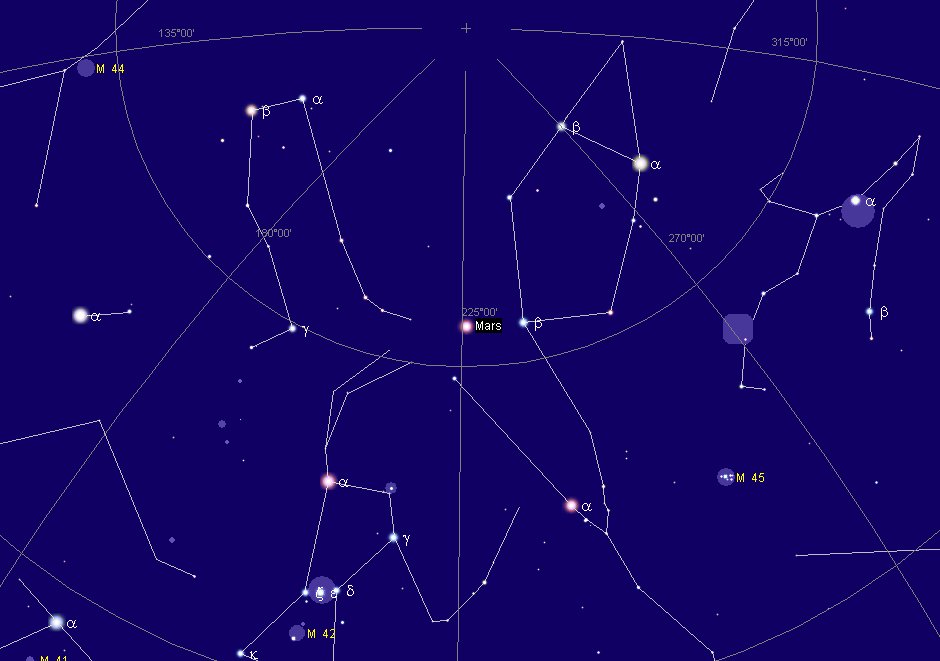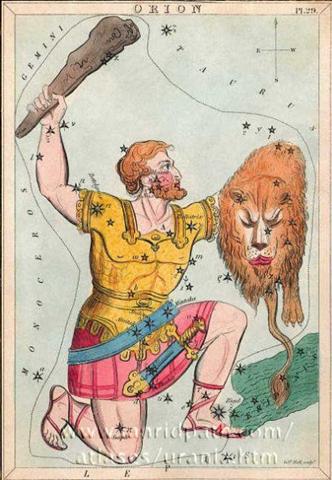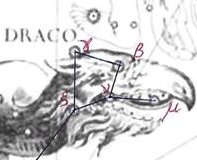4. Time for a reality check. Therefore I went out last evening a little later in order to be able to perceive the outlines of the major constellations. I took a path which brought us (me and my faithful dog) somewhat away from the brightest light disturbances of modern man.
But then the attention of my dog was suddenly caught by a fox who circled around us among the shadows at the very limit of sight. We walked slowly on in different worlds - I was looking up in different directions while my dog was looking around in different directions. Back home I could compare what I had seen with my own eyes (the ultimate verification) with what Cartes du Ciel was bringing forth. Indeed I had now seen Mars where it should be, viz. not yet in Gemini but between Orion and Auriga:
I had also seen how the brightest stars in Orion stretched in a line from Rigel (his Foot) past Tau-toru (the 3 stars) and up to the very bright Betelgeuze. From this I could then look higher up and find Auriga with its brightest star Capella (the Mother Goat), precisely where it should be, viz.straight above Rigel. It could be imagined that Rigel was hanging down like a 'heart' by a thread (a right ascension line) from Capella, cfr the illustration in Eb7-23: ... In the inscriptions of Dendera, published by Dümichen, the goddess Hathor is called 'lady of every joy'. For once, Dümichen adds: Literally ... 'the lady of every heart circuit'. This is not to say that the Egyptians had discovered the circulation of the blood. But the determinative sign for 'heart' often figures as the plumb bob at the end of a plumb line coming from a well-known astronomical or surveying device, the merkhet. Evidently, 'heart' is something very specific, as it were the 'center of gravity' ... See Aeg.Wb. 2, pp. 55f. for sign of the heart (ib) as expressing generally 'the middle, the center'. And this may lead in quite another direction. The Arabs preserved a name for Canopus - besides calling the star Kalb at-tai-man ('heart of the south') ... Suhail el-wezn, 'Canopus Ponderosus', the heavy-weighing Canopus, a name promptly declared meaningless by the experts, but which could well have belonged to an archaic system in which Canopus was the weight at the end of the plumb line, as befitted its important position as a heavy star at the South Pole of the 'waters below'. Here is a chain of inferences which might or might not be valid, but it is allowable to test it, and no inference at all would come from the 'lady of every joy'. The line seems to state that Hathor (= Hat Hor, 'House of Horus') 'rules' the revolution of a specific celestial body - whether or not Canopus is alluded to - or, if we can trust the translation 'every', the revolution of all celestial bodies. As concerns the identity of the ruling lady, the greater possibility speaks for Sirius, but Venus cannot be excluded; in Mexico, too, Venus is called 'heart of the earth'. The reader is invited to imagine for himself what many thousands of such pseudo-primitive or poetic interpretations must lead to: a disfigured interpretation of Egyptian intellectual life ...
Perceptions generate ideas (pictures). The fox, which hardly could be seen by me in the dusk, was first detected by my dog. Her eyesight is not very sharp as compared to mine (and compared to her nose of course), but she is quite capable of quickly perceiving anything which moves, even in the dim twilight (double light). What did this circling fox hard to see portend? Certainly she was leading me towards a comparison with the right ascension 'thong' between Spica and the Fox: ... Proclus informs us that the fox star nibbles continuously at the thong of the yoke which holds together heaven and earth; German folklore adds that when the fox succeeds, the world will come to its end. This fox star is no other than Alcor, the small star g near zeta Ursae Majoris (in India Arundati, the common wife of the Seven Rishis, alpha-eta Ursae ... ... The Arabs in the desert regarded it as a test of penetrating vision; and they were accustomed to oppose 'Suhel' to 'Suha' (Canopus to Alcor) as occupying respectively the highest and lowest posts in the celestial family. So that Vidit Alcor, et non lunam plenum, came to be a proverbial description of one keenly alive to trifles, but dull of apprehension for broad facts ...
|
||||||||||||||||||||||||||||||||||||||||||||||||||||||||||






